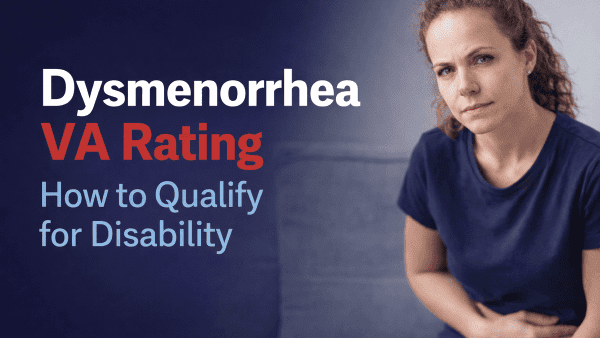Looking for Expert-Level VA Claim Answers?📱Call Us Now! 737-295-2226
Are you a veteran experiencing the uncomfortable and disfiguring symptoms of chloracne?
This skin condition can cause significant physical and emotional distress, leading to feelings of self-consciousness and social isolation.
Fortunately, as a veteran, you could be eligible for VA care with healthcare and VA disability.
In this article, we’ll break down what it takes to win your VA claim for chloracne and explain the process for filing a successful VA disability claim.
Table of Contents
Summary of Key Points
- Chloracne is a presumptive condition for veterans exposed to Agent Orange (including those who served in Vietnam or along the Korean DMZ).
- To win your claim, you must show current symptoms, an in-service exposure, and a nexus linking the two.
- The VA rates chloracne based on severity and location of the lesions. VA ratings range from 0% to 30%, or higher if scarring is also present.
- Veterans can receive an Agent Orange registry exam, which helps document symptoms and strengthen a claim.
What Causes Chloracne in Veterans?

Chloracne can be caused by exposure to certain toxic chemicals, particularly dioxins, an industrial pollutant. Veterans who served in the Vietnam War may have been exposed to dioxins through contact with Agent Orange. This herbicide was widely used during the war.
Dioxins can also be found in specific industrial settings, such as chemical manufacturing plants and waste incineration facilities, as well as in some consumer products, such as PVC plastics and bleached paper products.
When dioxins enter the body, they can disrupt the normal functioning of the sebaceous glands, which produce the oils that lubricate the skin. This can cause the glands to produce excessive sebum, leading to blackheads, whiteheads, and other types of acne-like lesions characteristic of chloracne.
In some cases, chloracne can persist for years or even decades after exposure to the toxic chemicals has ceased, which is why you may be experiencing chloracne after you leave military service.
How Chloracne Impacts Veterans
If you’re a veteran with chloracne, it can significantly affect you physically and emotionally.
The discomfort, pain, and scarring caused by this skin condition can be challenging to manage.
Its visible and often disfiguring appearance can lead to feelings of self-consciousness and low self-esteem. You may feel embarrassed or ashamed of your condition, especially if it’s on your neck or face, which can lead to social isolation and avoidance of social situations, such as work events or family gatherings. Even simple tasks like going to the grocery store can become overwhelming.
Managing chloracne may require ongoing medical treatment and monitoring, which can be time-consuming and expensive. All of these factors combined can have a profound impact on your quality of life. It’s important to seek medical attention and support to help manage chloracne’s physical and emotional effects.
Filing a VA Claim for Chloracne
To win a VA claim for chloracne, you’ll need to prove three things:
- You have current symptoms of chloracne
- You have an in-service event or injury that led to your development of chloracne (i.e.: exposure to Agent Orange)
- Your current symptoms are linked to your service (service connection)
Getting Service Connected for Chloracne
Service connection links a veteran’s military service and a medical condition. The three main service connection types are direct, secondary, and presumptive. For chloracne, the most relevant type of service connection is presumptive.
Presumptive service connection for chloracne is granted to veterans exposed to herbicides during their Vietnam service. They must experience chloracne within one year of exposure, with a minimum rating of 10%. Chloracne is one of two presumptive skin conditions related to Agent Orange (the other is porphyria cutanea tarda).
Proving through medical records that you began experiencing symptoms of chloracne within one year of service can help you service connect your condition, even if it’s years after you left military service.
If you served in Vietnam, the Korean DMZ, or another area where Agent Orange was used, you can request a free Agent Orange registry health exam. This helps you begin tracking any symptoms or other long-term health effects.
How the VA Rates Chloracne
Depending on your chloracne’s severity, the VA will likely rate you from 0% to 30%.
There are a few different rating methods the VA may use for you. The VA will rate your chloracne based on how it’s impacting you most, using the formula that gives you the highest rating. The VA will rate your chloracne based on Diagnostic Code 7829 or for any scarring (DC 7801, 7802, or 7804). Let’s start with DC 7829 first.
30% VA Rating
To be rated at 30%, your chloracne must be deep and affect 40% or more of your face and neck, causing inflammation and pus-filled cysts.
20% VA Rating
To be rated at 20%, your chloracne must affect at least one of the following areas: armpits, the genital region, the folds of the breast, or the areas between the fingers and toes, causing inflammation and pus-filled cysts.
10% VA Rating
To be rated at 10%, your chloracne must be deep but affect less than 40% of your face and neck. It could also impact areas other than your face and neck, causing inflammation and pus-filled cysts.
0% VA Rating
At the 0% rating, your chloracne is superficial, involving only one layer of the skin and not causing pus-filled cysts.
To learn more about earning a rating for any scarring caused by chloracne, read our guide to get a VA rating for scars.
Conclusion
If you believe your chloracne is connected to your military service—especially if you served in Vietnam or another area where Agent Orange was used—you may qualify for VA disability compensation. Don’t wait. The earlier you take action, the better.
Deserve a Higher VA Rating? WE GOT YOUR SIX!

- VA Claims Insider is the #1 most trusted name in VA disability claims.
- Work directly with a VA claims coach who can educate you to VA claim victory.
- 25,000+ disabled veterans have served in our membership programs since 2016.
- 30% average rating increase for veterans who complete our #1-rated Elite program.
- 4.7/5.0 average rating out of 5,500+ total reviews; over 4,500 5-star reviews.
FAQs | Frequently Asked Questions
What is chloracne?
Chloracne is a serious skin condition caused by exposure to toxic chemicals like dioxins—most notably Agent Orange, a herbicide used during the Vietnam War. Though it resembles traditional acne, chloracne is typically more severe and long-lasting, with lesions that can persist for years. Unlike regular acne, chloracne is directly linked to chemical exposure and often includes deeper, more painful cysts and scarring.
What are the symptoms of chloracne?
Chloracne can cause blackheads, whiteheads, painful cysts, reddish lesions, peeling skin, and scarring—typically on the face, neck, or upper body. Severe cases may involve fluid-filled cysts, thick facial hair growth, or systemic issues like fatigue or joint pain. If you notice these symptoms, seek medical care. A diagnosis can support your VA disability claim for Agent Orange exposure.
Is chloracne a presumptive condition for Agent Orange exposure?
Yes, chloracne is one of the conditions the VA presumes to be caused by Agent Orange exposure. View the Agent Orange Presumptive Conditions List
What if my chloracne appeared years after I left the military?
Even if your symptoms didn’t begin until years after service, you may still be eligible for VA disability. While presumptive service connection requires symptoms to appear within one year, many veterans develop delayed symptoms. In these cases, a well-supported medical Nexus letter is often the key to proving service connection. Be sure to document your symptom history and discuss possible toxic exposure with your healthcare provider.
What are the treatments for chloracne?
Chloracne treatment depends on severity but often includes topical retinoids, oral antibiotics, or laser therapy. Avoiding chemical exposure and adopting healthy lifestyle habits (e.g., proper diet, exercise, and stress management) can also help.
Author

Trisha Penrod
Trisha Penrod is a former active-duty Air Force officer. As an Intelligence Officer, she led teams of analysts to apply advanced analytic skills to identify, assess, and report potential threats to U.S. forces.
Trisha attended the U.S. Air Force Academy and holds an MBA from Webster University. After receiving an honorable discharge in 2018, Trisha worked as a growth marketer and utilizes her analytic skills to help others accomplish their business goals.



